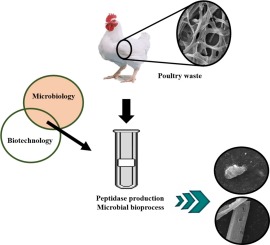当前位置:
X-MOL 学术
›
Process Saf. Environ. Prot.
›
论文详情
Our official English website, www.x-mol.net, welcomes your feedback! (Note: you will need to create a separate account there.)
Bioconversion of Chicken Feather Wastes by Keratinolytic Bacteria
Process Safety and Environmental Protection ( IF 7.8 ) Pub Date : 2020-03-01 , DOI: 10.1016/j.psep.2020.01.014 Samira Alahyaribeik , Seyed Davood Sharifi , Fatemeh Tabandeh , Shirin Honarbakhsh , Shokoufe Ghazanfari
Process Safety and Environmental Protection ( IF 7.8 ) Pub Date : 2020-03-01 , DOI: 10.1016/j.psep.2020.01.014 Samira Alahyaribeik , Seyed Davood Sharifi , Fatemeh Tabandeh , Shirin Honarbakhsh , Shokoufe Ghazanfari

|
Abstract Rhodococcus erythropolis, Geobacillus stearothermophilus and two Bacillus species (Bacillus pumilis, and Bacillus licheniformis) were evaluated for protease production using feathers as the sole carbon and nitrogen source. The B. licheniformis produced enzymes optimally at 40 °C and pH 10.0, while B. pumilis performed optimally at 37 °C and pH 7.0. Furthermore, the optimum conditions for enzyme production by G. stearothermophilus were 55 °C and pH 7.0–8.0, while for R. erythropolis they were 37 °C and pH 7.0. The maximum proteolytic activities of the protease produced by B. licheniformis, G. stearothermophylus and B. pumilis were 50.41, 9.91 and 35.41 U/ml after 48, 72 and 48 h of culture, respectively. With R. erythropolis, the maximum enzyme activity was 33.39 U/ml after 96 h of culture. Also, the production of soluble protein showed the same pattern as that of proteolytic protease. When the initial pH value was 10.0, culturing the feathers (30 g l−1) for four days at 40 °C resulted in the maximum production of soluble proteins (8.28 mg/ml) by B. licheniformis. These results suggest that new strategies for waste management have emerged after the introduction of keratinases in sustainable material development, which has industrials applications in green technologies.
中文翻译:

角蛋白分解菌对鸡羽毛废料的生物转化
摘要 使用羽毛作为唯一的碳源和氮源,对红球菌、嗜热脂肪地芽孢杆菌和两种芽孢杆菌(短小芽孢杆菌和地衣芽孢杆菌)的蛋白酶生产进行了评估。B. licheniformis 在 40 °C 和 pH 10.0 下最佳地产生酶,而 B. pumilis 在 37 °C 和 pH 7.0 下最佳地执行。此外,G. stearothermophilus 产酶的最佳条件是 55 °C 和 pH 7.0-8.0,而对于 R. erythropolis,它们是 37 °C 和 pH 7.0。培养 48、72 和 48 小时后,地衣芽孢杆菌、G. stearothermophylus 和短小芽孢杆菌产生的蛋白酶的最大蛋白水解活性分别为 50.41、9.91 和 35.41 U/ml。对于 R. erythropolis,在培养 96 小时后,最大酶活性为 33.39 U/ml。还,可溶性蛋白质的产生显示出与蛋白水解蛋白酶相同的模式。当初始 pH 值为 10.0 时,将羽毛 (30 gl-1) 在 40 °C 下培养四天会导致地衣芽孢杆菌产生最大的可溶性蛋白质 (8.28 mg/ml)。这些结果表明,在可持续材料开发中引入角蛋白酶后,出现了新的废物管理策略,在绿色技术中具有工业应用。
更新日期:2020-03-01
中文翻译:

角蛋白分解菌对鸡羽毛废料的生物转化
摘要 使用羽毛作为唯一的碳源和氮源,对红球菌、嗜热脂肪地芽孢杆菌和两种芽孢杆菌(短小芽孢杆菌和地衣芽孢杆菌)的蛋白酶生产进行了评估。B. licheniformis 在 40 °C 和 pH 10.0 下最佳地产生酶,而 B. pumilis 在 37 °C 和 pH 7.0 下最佳地执行。此外,G. stearothermophilus 产酶的最佳条件是 55 °C 和 pH 7.0-8.0,而对于 R. erythropolis,它们是 37 °C 和 pH 7.0。培养 48、72 和 48 小时后,地衣芽孢杆菌、G. stearothermophylus 和短小芽孢杆菌产生的蛋白酶的最大蛋白水解活性分别为 50.41、9.91 和 35.41 U/ml。对于 R. erythropolis,在培养 96 小时后,最大酶活性为 33.39 U/ml。还,可溶性蛋白质的产生显示出与蛋白水解蛋白酶相同的模式。当初始 pH 值为 10.0 时,将羽毛 (30 gl-1) 在 40 °C 下培养四天会导致地衣芽孢杆菌产生最大的可溶性蛋白质 (8.28 mg/ml)。这些结果表明,在可持续材料开发中引入角蛋白酶后,出现了新的废物管理策略,在绿色技术中具有工业应用。


























 京公网安备 11010802027423号
京公网安备 11010802027423号